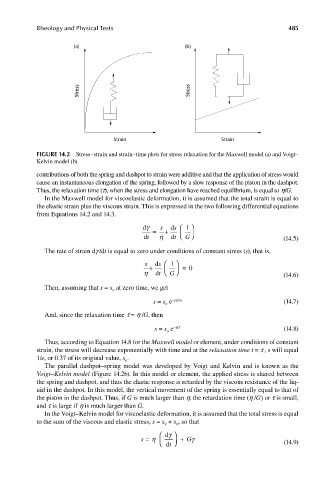Page 522 - Carrahers_Polymer_Chemistry,_Eighth_Edition
P. 522
Rheology and Physical Tests 485
(a) (b)
Stress Stress
Strain Strain
FIGURE 14.2 Stress–strain and strain–time plots for stress relaxation for the Maxwell model (a) and Voigt–
Kelvin model (b).
contributions of both the spring and dashpot to strain were additive and that the application of stress would
cause an instantaneous elongation of the spring, followed by a slow response of the piston in the dashpot.
Thus, the relaxation time (τ), when the stress and elongation have reached equilibrium, is equal to η G.
/
In the Maxwell model for viscoelastic deformation, it is assumed that the total strain is equal to
the elastic strain plus the viscous strain. This is expressed in the two following differential equations
from Equations 14.2 and 14.3.
dγ s ds 1
= +
dt η dt G (14.5)
The rate of strain dγ /dt is equal to zero under conditions of constant stress (s), that is,
s + ds 1 =
η dt G 0
(14.6)
Then, assuming that s = s at zero time, we get
o
s = s e −tG/n (14.7)
o
And, since the relaxation time τ = η /G, then
s = s e −t/T (14.8)
o
Thus, according to Equation 14.8 for the Maxwell model or element, under conditions of constant
strain, the stress will decrease exponentially with time and at the relaxation time t = τ , s will equal
1/e, or 0.37 of its original value, s .
o
The parallel dashpot–spring model was developed by Voigt and Kelvin and is known as the
Voigt–Kelvin model (Figure 14.2b). In this model or element, the applied stress is shared between
the spring and dashpot, and thus the elastic response is retarded by the viscous resistance of the liq-
uid in the dashpot. In this model, the vertical movement of the spring is essentially equal to that of
the piston in the dashpot. Thus, if G is much larger than η, the retardation time (η /G) or τ is small,
and τ is large if η is much larger than G.
In the Voigt–Kelvin model for viscoelastic deformation, it is assumed that the total stress is equal
to the sum of the viscous and elastic stress, s = s + s , so that
v o
dγ
s = η + Gγ
dt (14.9)
9/14/2010 3:42:28 PM
K10478.indb 485 9/14/2010 3:42:28 PM
K10478.indb 485

